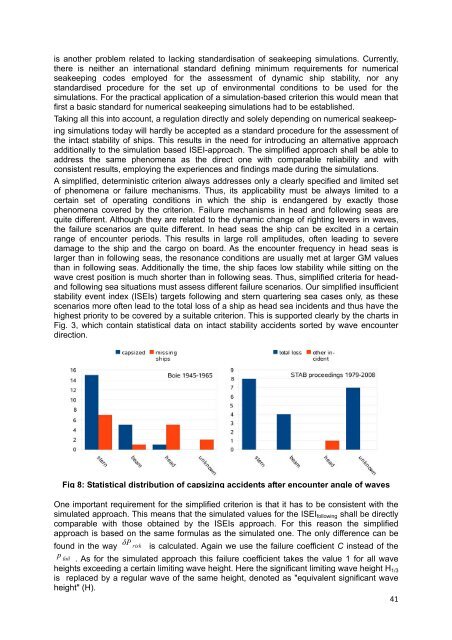SCHRIFTENREIHE SCHIFFBAU Festschrift anlässlich des 100 ...
SCHRIFTENREIHE SCHIFFBAU Festschrift anlässlich des 100 ...
SCHRIFTENREIHE SCHIFFBAU Festschrift anlässlich des 100 ...
Erfolgreiche ePaper selbst erstellen
Machen Sie aus Ihren PDF Publikationen ein blätterbares Flipbook mit unserer einzigartigen Google optimierten e-Paper Software.
is another problem related to lacking standardisation of seakeeping simulations. Currently,<br />
there is neither an international standard defining minimum requirements for numerical<br />
seakeeping co<strong>des</strong> employed for the assessment of dynamic ship stability, nor any<br />
standardised procedure for the set up of environmental conditions to be used for the<br />
simulations. For the practical application of a simulation-based criterion this would mean that<br />
first a basic standard for numerical seakeeping simulations had to be established.<br />
Taking all this into account, a regulation directly and solely depending on numerical seakeep-<br />
ing simulations today will hardly be accepted as a standard procedure for the assessment of<br />
the intact stability of ships. This results in the need for introducing an alternative approach<br />
additionally to the simulation based ISEI-approach. The simplified approach shall be able to<br />
address the same phenomena as the direct one with comparable reliability and with<br />
consistent results, employing the experiences and findings made during the simulations.<br />
A simplified, deterministic criterion always addresses only a clearly specified and limited set<br />
of phenomena or failure mechanisms. Thus, its applicability must be always limited to a<br />
certain set of operating conditions in which the ship is endangered by exactly those<br />
phenomena covered by the criterion. Failure mechanisms in head and following seas are<br />
quite different. Although they are related to the dynamic change of righting levers in waves,<br />
the failure scenarios are quite different. In head seas the ship can be excited in a certain<br />
range of encounter periods. This results in large roll amplitu<strong>des</strong>, often leading to severe<br />
damage to the ship and the cargo on board. As the encounter frequency in head seas is<br />
larger than in following seas, the resonance conditions are usually met at larger GM values<br />
than in following seas. Additionally the time, the ship faces low stability while sitting on the<br />
wave crest position is much shorter than in following seas. Thus, simplified criteria for head-<br />
and following sea situations must assess different failure scenarios. Our simplified insufficient<br />
stability event index (ISEIs) targets following and stern quartering sea cases only, as these<br />
scenarios more often lead to the total loss of a ship as head sea incidents and thus have the<br />
highest priority to be covered by a suitable criterion. This is supported clearly by the charts in<br />
Fig. 3, which contain statistical data on intact stability accidents sorted by wave encounter<br />
direction.<br />
Fig 8: Statistical distribution of capsizing accidents after encounter angle of waves<br />
One important requirement for the simplified criterion is that it has to be consistent with the<br />
simulated approach. This means that the simulated values for the ISEIfollowing shall be directly<br />
comparable with those obtained by the ISEIs approach. For this reason the simplified<br />
approach is based on the same formulas as the simulated one. The only difference can be<br />
found in the way<br />
41<br />
δP risk is calculated. Again we use the failure coefficient C instead of the<br />
p fail . As for the simulated approach this failure coefficient takes the value 1 for all wave<br />
heights exceeding a certain limiting wave height. Here the significant limiting wave height H1/3<br />
is replaced by a regular wave of the same height, denoted as "equivalent significant wave<br />
height" (H).

















